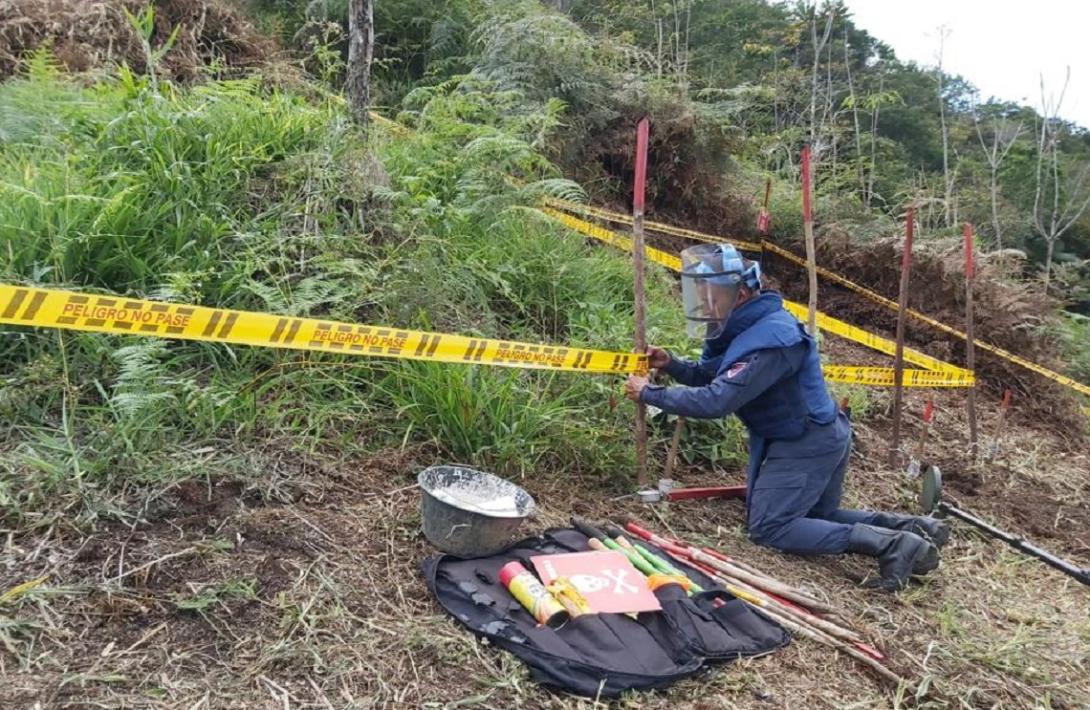In the village El Congal, in the municipality of Samaná, Caldas, every morning before the sun rises, each of the members of the Humanitarian Demining Battalion No.3 gets up with the same goal: to save lives.
With a heart full of good will, they take a bath, put on their uniform and those boots that will help them travel long ways in their daily tasks. Before going out, they recharge with a good breakfast.
“Today we are preparing for the visit eggs with chorizo, a traditional arepita and rice with onion, the traditional chocolate and coffee," says the troop's cook.
After getting their equipment ready, they travel for almost three hours, until they reach the day workplace. It is important to note that these soldiers travel unarmed.
“Within the humanitarian principles we have neutrality, operational independence, proportionality, among others, which make us closer to the people and not identify as regular troops. However, this makes us closer to the people and since we comply with international standards, we cannot be linked to the issue of armed groups,” says Colonel Andrés Guzmán, commander of the Humanitarian Demining Battalion No.3.
From this point, for approximately 45 minutes, the soldiers descend along trails and jungle ways, arriving at the work site, this time in the village of Las Mercedes, part of the Selva de Florencia National Natural Park, Caldas.
In this area of eastern Caldas, the 47th front of the extinct FARC under the command of alias Karina, planted explosive devices, minefields that today put at risk the lives of the peasants who are part of the communities in this territory.
“I think the work that the humanitarian demining group is doing here in our village is very important, as a resident here you live more uneasy with these mines, but with the arrival of the demining group you already feel calmer walking through the village because you already know what their operation is,” says Gilberto, a resident of Las Mercedes village.
With all the security measures, the soldiers put on the protective vest, with which the chest is protected, and the visor that will cover their faces.
Only manual demining is handled in the area, carried out by the mine clearance specialist, who is trained for approximately three months and who has as a tool a kit with a tweezer to prune the weeds and a metal detector to identify the mines.
It is a sharp sound that announces the detection of a new metal find, and with this a new opportunity to save a life. In case of an accident, the mine clearance specialists in the area have air availability to be evacuated and taken to receive first aid.
“As a security measure, we have at the moment an air availability in case of an accident, we have a UH60 with a nurse system and an extraction system, we have at this point an extraction point, the aircraft cannot land but it will be in a rappel system,” narrates Sergeant Edwin Calderón, leader of humanitarian demining operations.
During 2023, the men and women of the Humanitarian Demining Engineer Brigade have intervened 581,551 square meters, found and destroyed 27 anti-personnel mines, 11 unexploded ordnance and 2 improvised explosive devices.
“Gentlemen mine clearance specialists, we must continue to work with the mission of freeing suspected mines land, so that all the inhabitants of Colombia can return to their lands and make them productive.” These are the words that Colonel Guzmán says to his troops and at the same time, he gives a message of tranquility to the inhabitants, indicating that the work is done with high standards.
From this area of Colombia, the mine clearance specialists continue to work with the mission of freeing land from suspected mines so that the inhabitants can move peacefully and build a life without fears.
Source: Strategic Communications – General Command of the Military Forces





